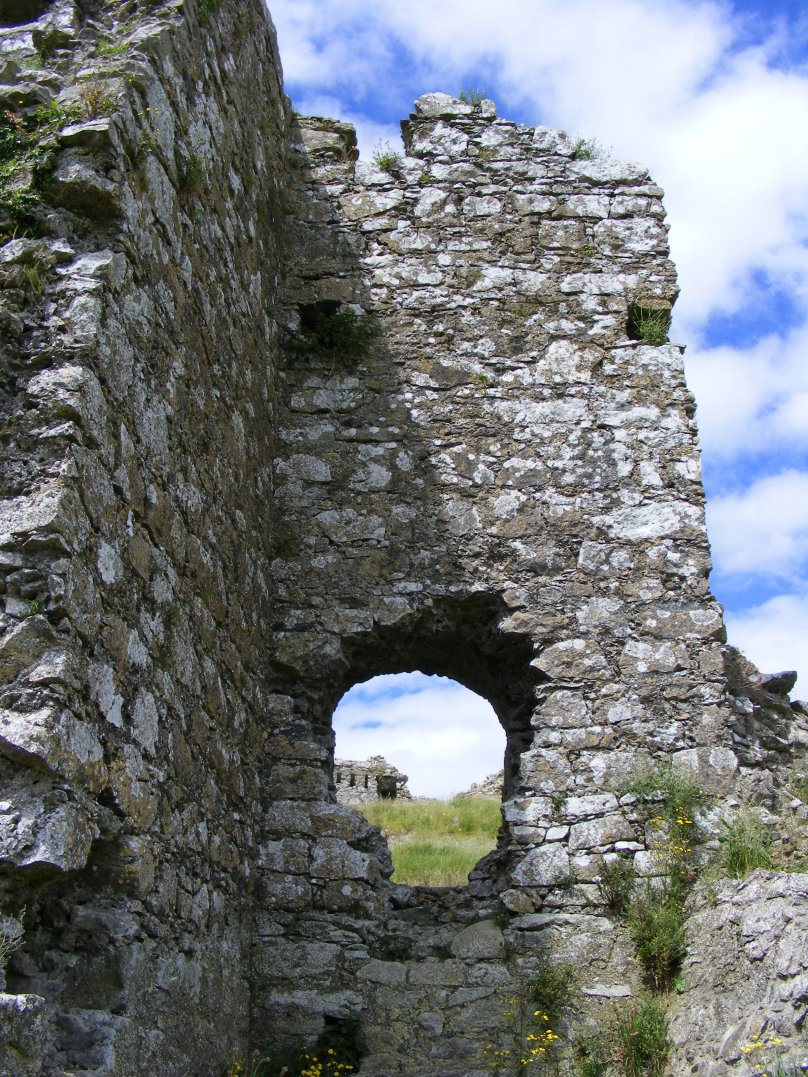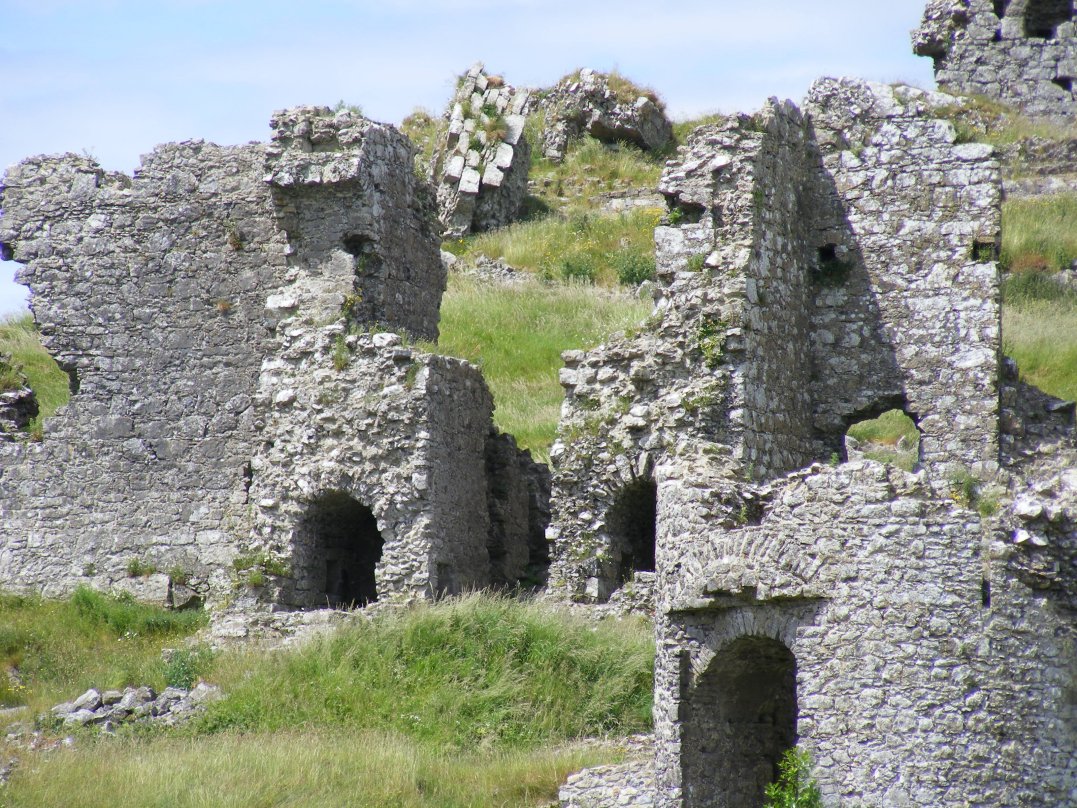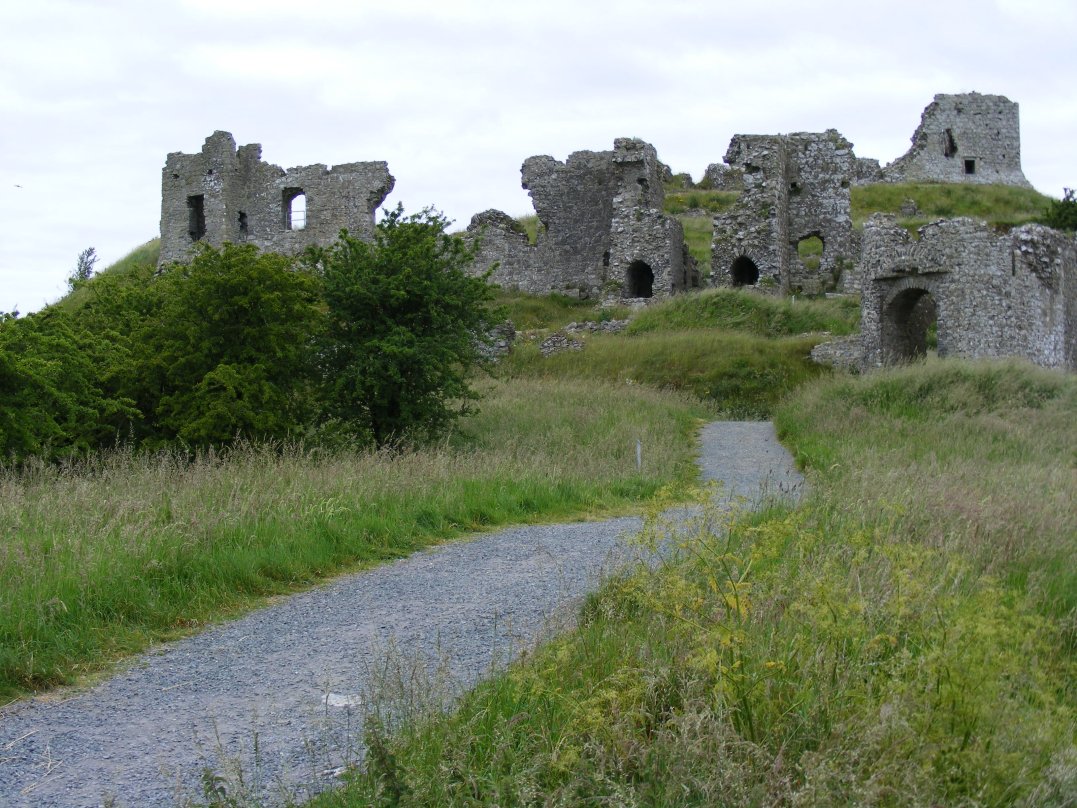Dunamase Castle
Excavations in the 1990s demonstrated that the Rock of Dunamase was
first settled in the ninth century when a hill fort or dun was constructed on
the site. This was known as Dun Masc, or Masc's Fort. Masc was the son of Ugen, a king said to be of manifold beauty. According to the Metrical Dindseanchas:
Six sons had blameless Ugen, who was eager willed for every exploit;
they bathed [their blades] abundantly, they built raths and great fortresses
Ladru, Noe, Finteng of the feats, Luad Cuar and Alb skilled in devices;
and Masc the sixth and eldest won fame from every family.
Noe in the west of Rechet unbetrayed found covering of good soil.
Masc mightiest with spear, in his impregnable stronghold dwelled undespoiled.
It would appear that Masc's impregnable stronghold was Dunamase. Several chronicles record the fall of Dun Masg in 843/4, when the Vikings of Dublin attacked the site and
captured Aed son of Dub dá
Chríchthe,
the abbot of Terryglass. He was carried off into Munster where he
'suffered martyrdom'. In the recent excavations a coin of
Ecgberht of Wessex (802-39) was found. It is thought that the
masonry remains visible to the right of the main gatehouse outside the curtain wall are the remains of Dun Masgand that the fall of the fort ended
fortification at the site until the second half of the twelfth century when Dunamase
was refortified by the MacMurrough kings of
Leinster. King Dermot MacMurrough of Leinster (d.1171) brought the wife of King Tierman O'Rourke of Breifne (d.1172) here after
kidnapping her. As a consequence the O'Connor and O'Rourke clans drove
MacMurrough from Dunamase, forcing him to flee from Ireland.
In response MacMurrough gave Dunamase and his daughter Aoife in
marriage to the Norman, Earl Richard Clare of Pembroke in 1170, as part of a deal to
enlist his help to regain his lands. The result was the
Anglo-Norman-Welsh invasion of Ireland when Clare accompanied MacMurrough, along
with many men, to attack and regain his kingdom. Throughout Ireland Earl Clare is still remembered as Strongbow, although this was not his name. He was actually lord of Chepstow that was then known as Strigoil and this is where the alleged nickname actually came from.
 After Clare's death in 1176, Princess Aoife seems to have resided mainly in England and appears to have ended her days in Goodrich castle.
Her lands in Ireland passed to Crown officials, until in 1189
King Richard I granted Aoife's daughter
and heir, Isabel Clare, in marriage to William Marshal, who was to
become earl of Pembroke as well as lord of Dunamase. Earl
William betrayed King John early in the thirteenth century and consequently lost
Dunamase to the king. In 1211 the royal sheriff rendered an
account of £53 6s 8d for the farm of the Irish of Dunamase and
£13 6s 8d for the farm of the English as well as for the
mill. He also rendered £6 for the land on which Dunmalc castle was situated. Damas
castle was returned to Earl William on 20 August 1215. Even so,
the royal barons of Ireland apparently did not agree with this move and
on 31 August the king found himself obliged to order the justiciar of
Ireland to order Godfrey Luterel to return the castle of Dunmathto
Earl William 'as he had already been commanded to do'. The castle
seems to have played no part in Earl William Marshall's war against
Hugh Lacy (d.1242) in 1224, but on 22 April 1225, the king did allow
William the service due to the king ‘to enable the earl to
fortify a castle in Ireland'. Possibly this was Dunamase.
After Clare's death in 1176, Princess Aoife seems to have resided mainly in England and appears to have ended her days in Goodrich castle.
Her lands in Ireland passed to Crown officials, until in 1189
King Richard I granted Aoife's daughter
and heir, Isabel Clare, in marriage to William Marshal, who was to
become earl of Pembroke as well as lord of Dunamase. Earl
William betrayed King John early in the thirteenth century and consequently lost
Dunamase to the king. In 1211 the royal sheriff rendered an
account of £53 6s 8d for the farm of the Irish of Dunamase and
£13 6s 8d for the farm of the English as well as for the
mill. He also rendered £6 for the land on which Dunmalc castle was situated. Damas
castle was returned to Earl William on 20 August 1215. Even so,
the royal barons of Ireland apparently did not agree with this move and
on 31 August the king found himself obliged to order the justiciar of
Ireland to order Godfrey Luterel to return the castle of Dunmathto
Earl William 'as he had already been commanded to do'. The castle
seems to have played no part in Earl William Marshall's war against
Hugh Lacy (d.1242) in 1224, but on 22 April 1225, the king did allow
William the service due to the king ‘to enable the earl to
fortify a castle in Ireland'. Possibly this was Dunamase.
The fortress remained under Earl William until on 11 April 1231 the constables of the Marshall castles of Kilkenny, Odoch, Wexford, Ros, Dunamase (Dumas), Carlow (Katherlach), Kildare, Kerry and De Insula
were informed that their Lord William Marshall was dead and that they
were now mandated to obey Walerand Teuton in his place. The
castle then passed to Earl Richard Marshall who was killed by the
Geraldines at Curragh near Kildare in April 1234 after he had rebelled
against Henry III. The castle then passed to Richard's brother, Gilbert Marshall, who on 25 May 1234, was ordered to
turn Chepstow castle over to the archbishop of Canterbury and Dumas
castle over to the archbishop of Dublin for the king to remit against
him his 'anger and indignation and grant that he could return into the
king's peace and service'. The king also noted that he would not
seize either castle into his own hand to the disherison of Gilbert or
his heirs. The seizure in any case was only nominal for on 31 May
1234 the king returned the rest of Gilbert's Irish lands and ordered
Dunamase castle itself returned on 22 August.
In 1247, after the death of Earl Gilbert's last brother and heir, the Marshal lands were divided among
the elder William Marshall's 5 daughters, Dunamase falling to Eva Marshal and then to
her daughter, Matilda Braose (d.1301), who by this time was married to Roger Mortimer of Wigmore (d.1282).
At this time the castle and barony were worth £104 19s 1d, plus
another £3 1s 10d which was assigned to the earl of Gloucester as
his part of the inheritance.
In 1264, as part of the baron's wars sweeping through England, the
Geraldines - the descendants of Gerald Windsor - fought against Earl
Walter Burgh of Ulster. As a result of one action, Maurice Fitz
Maurice (1238-86) captured the justiciar of Ireland, Richard Rokele as
well as Theobald Butler (1242-85), the lord of Nenagh castle,
and John Cogan and imprisoned them at Dunamase. Later in 1280-81,
another prisoner held in Mortimer's castle of Dunamase was King
Muirchertach MacMurrough of Leinster. On the death of
Roger Mortimer in October 1282 it was found that Dunamase lordship was
worth a little over £35 per annum. This suggests that the
land, if not the castle, had been seriously disrupted in the past 30
years.
The castle remained in Mortimer hands until 1321 when it was seized by
forces loyal to King Edward II and given to the earl of Kildare.
The castle was returned to Mortimer in 1327, though retaken by the
Crown in 1330 when Roger Mortimer was executed for treason.
The king granted the castle to Fulke de la Freigne in 1334, but he
seems to have been held out of ownership by first the men of the
deceased earl of Kildare who claimed the right to the fortress by the
1321 grant of Edward II and then after 1335 by Lysaght O'More.
The result was an intermittent war that went on until O'More's
death in 1342. A chronicle listed one of Lysaght's achievements
as being 'the destruction of the noble Dunamase castle'.
Excavation has shown that the gatehouse at least was destroyed by
burning around this time. Evidence of this can still be seen in
the reddening of some stones in this structure. When Connell
O'More made his peace with Justiciar Walter Birmingham of Ireland in
1346/7, he claimed to hold some of his lands of Donmaske manor of the
Mortimers. Indeed when an O'More made his submission to King
Henry VIII on 24 August 1538 he finally agreed to renounce his claim to
Dunamase castle, even though the fortress had apparently been derelict
since the 1330s.
Despite claims that in 1641 the castle
was seized by Charles Coote and then taken by Catholic forces under
Eoghan Rua O'Neill in 1646, as well as there being a resultant
counter-attack in
1650 that left the castle heavily damaged, there is no
contemporary evidence that any of this ever happened. However, at
the end of the eighteenth century, Sir John Parnell began to restore Dunamase
keep to create a banqueting hall. It was his importation and inclusion
of later medieval cut stone windows, doors etc., taken from local
ruins, which has given rise to the impression of a later phase of
occupation.
Description
The castle rock is bell-shaped with a much smaller outer ward to the
east. On the summit of the hill stands a massive keep over 115'
long and 66' wide with walls up to 9' thick. The base of the
keep was equipped with a powerful plinth, the rubble masonry of which
is of a better quality than the external curtains. The
apparently original embrasures have round-headed Romanesque embrasure
roofs. The original structure only appears to have been one
storey high, so may have simply been a large hall.
The large inner ward, over 330' across, has irregular walls 6' thick covering
the summit of the rock. A wallwalk can still be seen to the east
about 12' above internal ground level, while there is a slight plinth
at the wall base. Most of the defences are crowded to the east
where the easy approach from the outer ward lies. These
consist of a rectangular gatehouse and a series of ruined, rectangular
buildings, one of which may have been an early entrance to the site,
another may have been a long hall. The curtain wall has a
rectangular, open-backed turret at the SE corner where it joins the
outer ward. Beside this tower is what appears to be a postern
doorway leading into the outer ward, while the ground floor east loop has
been converted - or was designed as - the entrance onto the outer
curtain wallwalk.

Internal buildings seem to have lain along the east inner wall too,
judging from the loops cut through it, although the only intact one, south
of the gatehouse, is a normal crossbow loop. The tallest
surviving fragment of curtain towards the north still has 3 post holes in
it which show that the wall was once equipped with a wooden
hoarding. To the south is a weak-walled long barbican and
postern, somewhat reminiscent of those at Carreg Cennen, Dinefwr and
Denbigh. This is an obvious
addition to the inner ward
curtain and once again this work contains ground floor crossbow
loops. The inner ward was subdivided with a 4' thick wall N&S
from the keep to make an upper ward to the west and a lower one to
the east.
The outer ward is about 100' across and has a single D shaped gatetower
at the point of access. This has a constable's chamber above with loops
covering the approach and a murder hole within the porcullisless
gate. The upper chamber was reached via a flight of straight
steps within the tower built against the north
wall. Steps lead
down from the gatetower to the curtain wallwalk to the west.
Presumably the same layout exists to the south, but this portion of wall
has
collapsed. The low polygonal curtain behind the rock-cut
ditch was well equipped with deeply splayed crossbow loops, which
parallel those of the inner ward east curtain. Such ground floor
loops in a curtain are not common and are found elsewhere, possibly at
Adare as well as at Aguillar in France and Beaumaris, Flint, Grosmont and Rhuddlan in Wales. Similar loops can be seen in the early work at Goodrich and the 1220s work at Rochester in England. The rubble
masonry of this wall at Dunamase is made of much smaller blocks than the inner ward
defences, which again emphasises that it was constructed at a later
date.
If you would like to visit this and
other great castles of Ireland I am leading a tour there in
October. Please
feel free to look over the details by clicking
here.
Copyright©2017
Paul Martin Remfry


 After Clare's death in 1176, Princess Aoife seems to have resided mainly in England and appears to have ended her days in Goodrich castle.
Her lands in Ireland passed to Crown officials, until in 1189
King Richard I granted Aoife's daughter
and heir, Isabel Clare, in marriage to William Marshal, who was to
become earl of Pembroke as well as lord of Dunamase. Earl
William betrayed King John early in the thirteenth century and consequently lost
Dunamase to the king. In 1211 the royal sheriff rendered an
account of £53 6s 8d for the farm of the Irish of Dunamase and
£13 6s 8d for the farm of the English as well as for the
mill. He also rendered £6 for the land on which Dunmalc castle was situated. Damas
castle was returned to Earl William on 20 August 1215. Even so,
the royal barons of Ireland apparently did not agree with this move and
on 31 August the king found himself obliged to order the justiciar of
Ireland to order Godfrey Luterel to return the castle of Dunmathto
Earl William 'as he had already been commanded to do'. The castle
seems to have played no part in Earl William Marshall's war against
Hugh Lacy (d.1242) in 1224, but on 22 April 1225, the king did allow
William the service due to the king ‘to enable the earl to
fortify a castle in Ireland'. Possibly this was Dunamase.
After Clare's death in 1176, Princess Aoife seems to have resided mainly in England and appears to have ended her days in Goodrich castle.
Her lands in Ireland passed to Crown officials, until in 1189
King Richard I granted Aoife's daughter
and heir, Isabel Clare, in marriage to William Marshal, who was to
become earl of Pembroke as well as lord of Dunamase. Earl
William betrayed King John early in the thirteenth century and consequently lost
Dunamase to the king. In 1211 the royal sheriff rendered an
account of £53 6s 8d for the farm of the Irish of Dunamase and
£13 6s 8d for the farm of the English as well as for the
mill. He also rendered £6 for the land on which Dunmalc castle was situated. Damas
castle was returned to Earl William on 20 August 1215. Even so,
the royal barons of Ireland apparently did not agree with this move and
on 31 August the king found himself obliged to order the justiciar of
Ireland to order Godfrey Luterel to return the castle of Dunmathto
Earl William 'as he had already been commanded to do'. The castle
seems to have played no part in Earl William Marshall's war against
Hugh Lacy (d.1242) in 1224, but on 22 April 1225, the king did allow
William the service due to the king ‘to enable the earl to
fortify a castle in Ireland'. Possibly this was Dunamase. 